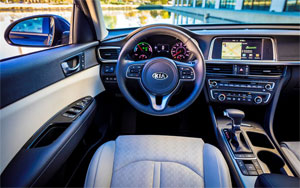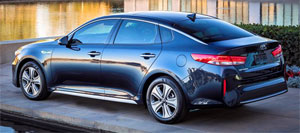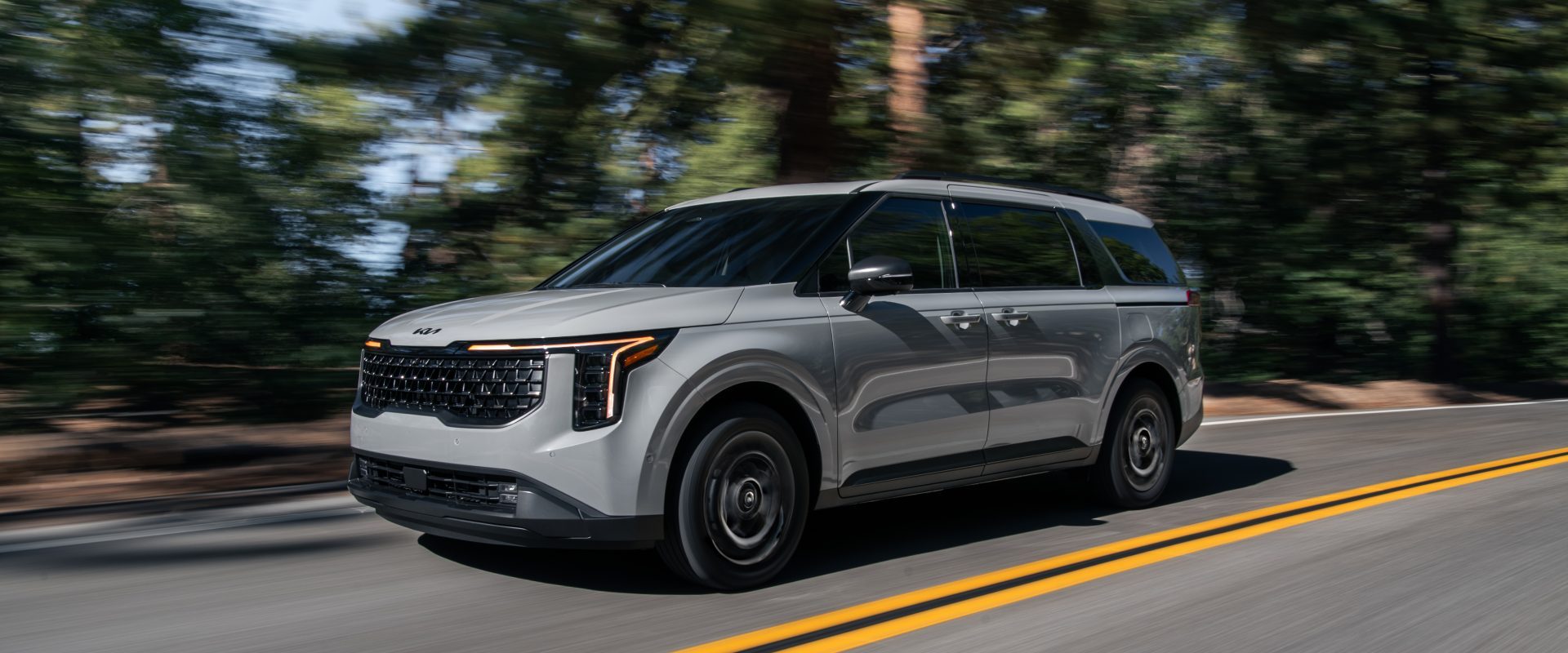2017 Kia Optima Hybrid
The euro-styled kia optima mid-size sedan has been quite a hit for the brand, and a favorite of ours here at Motorweek as well. But what most people may not realize is that the optima lineup includes a gasoline-electric hybrid. And for 2017, it gets a full redesign, encompassing all of the benefits of the optima’s new 4th generation chassis.
Kia has actually had a high mileage hybrid in the Optima lineup since 2011. And with the 4th generation of Kia’s midsizer kicking off last year, 2017 sees an all-new powertrain for this gasoline-electric. The new hybrid system consists of 2.0-liter I4, downsized from the previous gen’s 2.4-liter. But, there’s a bigger electric motor in place to aid it, 38-kW compared to last year’s 30-kW motor. Combined, horsepower is actually down from 206 to 192; but torque is much torquier, climbing from 195 lb-ft. to 271.
 Battery size increases from 1.4 to 1.6-kWh; and as before, it’s placed under the rear trunk floor, robbing a bit of storage space, though keeping the split/folding seatbacks in play. Capacity is 13.4 cubic-ft., compared to the base sedan’s 15.9. Thankfully, the transmission is still a 6-speed auto; and there’s been no change to a CVT. Government Fuel Economy Ratings are 39-City, 46-Highway, and 42-Combined; so our average of 41.7 miles-per-gallon on Regular was just about spot on. That makes for a very good Energy Impact Score, with use of just 7.8-barrels of oil per year while emitting just 3.5-tons of CO2.
Battery size increases from 1.4 to 1.6-kWh; and as before, it’s placed under the rear trunk floor, robbing a bit of storage space, though keeping the split/folding seatbacks in play. Capacity is 13.4 cubic-ft., compared to the base sedan’s 15.9. Thankfully, the transmission is still a 6-speed auto; and there’s been no change to a CVT. Government Fuel Economy Ratings are 39-City, 46-Highway, and 42-Combined; so our average of 41.7 miles-per-gallon on Regular was just about spot on. That makes for a very good Energy Impact Score, with use of just 7.8-barrels of oil per year while emitting just 3.5-tons of CO2.
That’s a significant improvement over last gen for sure, but still short of many other hybrids out there. For those looking for more, a plug-in version with a larger battery and up to 27 miles of EV-only driving is on the way. As for daily use, the Optima hybrid makes some noises you wouldn’t hear in a typical petrol Optima, but otherwise operates with the same smooth, Euro-like demeanor. After an hour or two behind the wheel, it’s easy to forget you’re even in a hybrid. If you wish to be reminded, a new Eco-Driver Assistance System will coach you on how to get the most efficiency as possible, with prompts in the IP, as well as with audible alerts. With very good steering feel, this gen’s stiffer chassis, and the aforementioned transmission; this is one hybrid we truly enjoyed driving.
 There’s good comfort in all seating positions and plenty of nice soft touch materials. EX trim comes with heated leather seats, heated steering wheel, surround sound, and navigation. Adding the Technology package will get you a panoramic sunroof, ventilated front seats, heated rear seats, and a host of safety systems including Autonomous Emergency Braking. The exterior differs little from base Optima. That’s a good thing as far as we’re concerned, as we feel the Optima is one of the best looking rides in the family sedan segment.
There’s good comfort in all seating positions and plenty of nice soft touch materials. EX trim comes with heated leather seats, heated steering wheel, surround sound, and navigation. Adding the Technology package will get you a panoramic sunroof, ventilated front seats, heated rear seats, and a host of safety systems including Autonomous Emergency Braking. The exterior differs little from base Optima. That’s a good thing as far as we’re concerned, as we feel the Optima is one of the best looking rides in the family sedan segment.
But, nothing is for free, as there’s always a price to pay. Here, it starts at $26,890 in Premium trim, or about a grand less than the stingier Toyota Camry Hybrid. Optima Hybrid in EX trim, at $31,885, is about 5-grand over a standard non-hybrid Optima.
The 2017 Kia Optima may come up short when it comes to absolute fuel economy. But, much like the Ford Fusion Hybrid and Chevrolet Malibu Hybrid, it offers handsome styling, and a traditional sedan feel, that many other modestly priced hybrids can’t match, plus, it adds a unique driving experience that’s clearly European in flavor. So, don’t look at the Optima Hybrid as the ultimate hyper-miler’s choice, but a more efficient option for those looking for a roomy, great looking, fine driving car.
Specifications
- Engine: 2.0-liter I4
- Horsepower: 192
- Torque: 271 lb-ft.
- EPA: 39 mpg city / 46 mpg highway
- Energy Impact: 7.8 barrels of oil/yr
- CO2 Emissions: 3.5 tons/yr
2025 Kia Carnival Hybrid
Kia Adds Hybrid Assistance To Keep The Party Going
For 2022, Kia gave their minivan a major reboot. So much so, they changed the name to Carnival and even stopped calling it a minivan. Well, they can’t fool us though. After all, we love minivans for their all-around practicality. Well for 2025, Kia has updated its multi-purpose people mover, including adding hybrid power. So, let’s see if that makes time in the new Carnival even more festive.
With many brands no longer even competing in the minivan segment, it’s noteworthy that not only is Kia still in the game, they’ve given their multi-purpose 2025 Carnival a major update after only 3 years on the market. That update includes a first-time optional hybrid powertrain.
The Carnival Hybrid config is an extension of the Sorento SUV’s setup, pairing a 1.6-liter turbo-four engine with a larger 54-kW electric motor. Combined output of 242 horsepower, 15 more than Sorento. Total torque is a stout 271 lb-ft, getting to the front wheels through a true six-speed automatic transmission. Throw in a full 19-gallon fuel tank and you’ve got close to 600 miles of range, allowing you to keep the party going farther than before.
The V6 Carnival remains available, although it’s now listed at 287 horsepower, down from 290. But the Government Fuel Economy Ratings take a huge leap here in the Hybrid; from 18 City, 26 Highway, 21 Combined to 34 City, 31 Highway, and 33 Combined.
The Hybrid comes with a few additional tricks up its sleeve, the most noticeable being the dial-like shifter in the console. But there is also a pretty clever regen braking setup that Kia calls E-VMC. The Electrification-Vehicle Motion Control has three levels of regen, but also has an E-Handling component which adjusts regen going into corners and amounts of electric assist when coming out of them; E-Ride, which includes unique shock tuning for the Hybrid but also can engage the electric motors to mitigate harsh impacts; and E-Evasive Handling Assist, which kicks in during emergency maneuvers. All techy cool!
Another step in Kia’s efforts of making everyone forget this MPV is actually a minivan.
All Carnivals regardless of powertrain get updated styling for ’25 which includes a new face that trades the concave grille for a flatter, larger one. The headlights are no longer incorporated into the grille, and the daytime running lights are much snazzier. In back, the taillights take on a completely different look, with much larger vertical elements on the sides. The liftgate gets a chunkier SUV-like vibe and the rear bumper is more pronounced than before. Altogether, another step in Kia’s efforts of making everyone forget this MPV is actually a minivan.
There’s upgraded tech for the inside, namely Kia’s new frameless panoramic display that incorporates both the 12.3-inch driver display and 12.3-inch touchscreen infotainment. It not only looks better, but processing speeds are much faster. The driver’s display gets a completely new theme with modern bar and number style speed displays instead of virtual gauges. A Full Display Mirror is also now available, which can switch from traditional mirror to camera.
The Hybrid has a bit less horsepower but 10 additional lb-ft of torque, so off to Mason Dixon Dragway for some numbers. It certainly didn’t feel underpowered, spinning up the tires off the line and even chirping on the shift into second. We hit 60 in a respectable 8.0 seconds, which is still .80 slower than the V6. Our best quarter-mile time was 16.2 seconds at 88 mph.
There was a different vibe to the handling experience, as E-Handling virtually eliminated understeer. But there was still some body roll and stability systems were eager to engage quickly. The brakes retain a natural feel, and stopping distances averaged a good 110 feet from 60.
The Carnival Hybrid is available in four of the Carnival’s five trims, all but the base LX. So, a base LXS Hybrid goes for $42,235, a $2,000 premium over the V6.
The 2025 Kia Carnival Hybrid offers more than just much better fuel economy. Kia has found a way to integrate battery assistance into just about every mechanical aspect of the vehicle, delivering a driving experience that is unique from its V6 counterpart, and adding more good vibes to an already exceptional family vehicle.
Specifications
As Tested
- Engine: 1.6-liter turbo-4
- Transmission: 6-speed automatic
- Horsepower: 242
- Torque: 271 lb-ft
- 0-60 mph: 8.0 seconds
- 1/4 Mile: 16.2 seconds at 88 mph
- Braking, 60-0 (avg.): 110 feet
- EPA: 34 City | 31 Highway | 33 Combined







